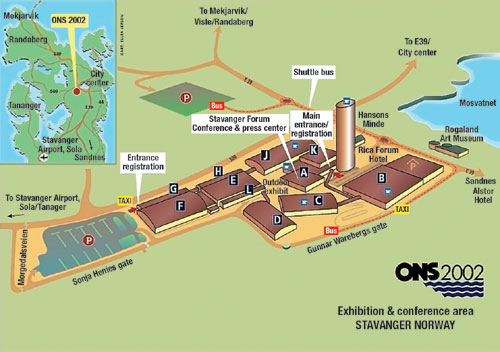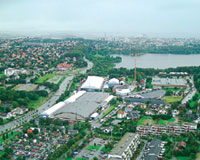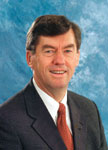Offshore Northern SeasONS targets a new generation of industry leaders and innovatorsAgenda/preview for the Offshore Northern Seas conference and exhibition, Stavanger Forum showgrounds, Stavanger, Norway, August 27 – 30, 2002A new approach is being taken at this year’s Offshore Northern Seas (ONS) conference. The focus will be on the next generation of oil and gas industry leaders, as well as new technology and environmental challenges. "Energizing a new generation" is the theme for ONS 2002, the 15th ONS conference, which will be staged in Stavanger, Norway, August 27 – 30, 2002. This reflects a desire on the part of the conference committee to be energetic and innovative, while maintaining the significant professional and political prestige that this event has gained since its inception in 1974. Exhibition ONS has become an important marketplace and forum for the global offshore industry. From a modest start in 1974, the show has grown in line with North Sea operations, and beyond. In 1974, there were 310 companies exhibiting in just 200 stands covering about 7,500 sq m (80,730 sq ft); attendees numbered only 9,350. During the last ONS in 2000, the numbers had swollen to 1,128 companies in 590 stands covering 17,204 sq m (185,184 sq ft), with 29,204 attendees present. This year, somewhere between 1,200 and 1,300 exhibitors from nearly 40 countries will occupy roughly 500 stands, again covering just over 17,000 sq m (183,000 sq ft). Attendance is expected to total close to 30,000. At press time, the show was fully booked, and several companies were on a waiting list. ONS officials said that they intended to explore options for ensuring that all firms have a place by the show’s opening day. Joint stands have been booked by numerous countries, including the U.S., Russia, France, Germany, the UK, Australia, Canada and the Netherlands. After several years’ absence, China will return to ONS. In addition, large delegations are also planned by both the European Commission and the coordinating committee for geoscience projects in eastern and southeastern Asia (CCOP). A new hall that forms part of the Stavanger Forum showground’s expanded conference facilities will provide the entry point to this year’s show. Presentations in this building, Hall K, will include more than 20 handpicked "incubator" companies. These firms have been invited by ONS to present new products that have the potential to achieve significant stature within the industry. The new hall will also house an "investment recovery park" that focuses on oil re-use and recycling installations, and also presents Stavanger as a world energy city.
Conference Program ONS committee members have assembled a forward-looking program (see accompanying table) that emphasizes younger industry leaders, as well as new technology and environmental issues. "I know that the conference committee intends delegates to see a difference from earlier ONS programs from the opening day," said Kjell Ursin-Smith, managing director of the ONS Foundation. "As usual, our emphasis has been on high-quality speakers addressing very important issues. But we feel we’re also going to be a trendsetter in our field this time." The first afternoon on Tuesday, August 27, features a global panel that includes, among others, Nigerian Presidential Petroleum Advisor, Dr. Rilwanu Lukman; Algerian Energy & Mines Minister, Dr. Chakib Khelil; Simon Kukes, president of Russia’s TNK; Norsk Hydro President and CEO Eivind Reiten and Phillips Petroleum Chairman and CEO Jim Mulva. Some panel members will be participating remotely, so Schlumberger and Norsk Hydro will furnish technical support to bring these panelists to ONS via satellite. On the technical side of the program, natural gas will be a dominant theme. The entire morning of Wednesday, August 28, is filled by two parallel sessions that look at gas production, supply and usage issues. Upstream technology and operational issues are also covered by multiple sessions in both the morning and afternoon on Thursday, August 29. Policy, planning and management topics get an airing in sessions on the afternoons of Tuesday and Wednesday. The focus during the closing session on Friday, August 30, will be on young people in the oil, gas and energy sectors, with teams from eight companies presenting their future scenarios for the industry. These groups will be comprised of young men and women that the ONS committee believes represent the best quality and talent in the business. Their views will be contrasted with a contribution from 91-year-old Arne Næss, Sr., a prominent Norwegian philosopher, who is described as having "strong, visionary beliefs on what the future holds." The teams will use multimedia techniques and other modern technology in their presentations, which will be judged by the audience with the aid of push-button voting.
Other Features A series of presentations on exploration opportunities in a number of highly prospective countries will also be staged as part of ONS. These Exploration Promotion Forums will feature delegations from Australia, Angola, Azerbaijan, Canada, Iran, Nigeria and Russia. For the first time, these presentations will include Southeast Asian countries that have offshore operations – Cambodia, China, Indonesia, South Korea, Malaysia, Papua New Guinea, the Philippines, Thailand and Vietnam. A delegation of more than 20 officials from Houston, headed by Mayor Lee P. Brown, will pay an official visit to Stavanger and ONS 2002 on August 26 – 28. This will be the first trip by the top leadership of America’s "oil capital" to its Norwegian counterpart, and the ONS conference and exhibition. At press time, some details of the Houston group’s visit remain to be clarified. However, Brown’s office did announce that it would form one leg of an extensive international relations and business development mission to Europe. Stavanger and Houston are Sister Cities, and they are also members of the 11-city World Energy Cities Partnership (WECP). During the Offshore Technology Conference in Houston this past May, Brown announced that his city had accepted the role of serving as secretariat for WECP. Other members include Aberdeen, Baku, Daqing (China), Dongying (China), Halifax (Nova Scotia, Canada), Maracaibo (Venezuela), Perth, St. Johns (Newfoundland, Canada) and Villahermosa (Mexico). First organized in 1992, the Stavanger Oil Festival has developed into an important part of ONS. It is staged in the city’s picturesque center, surrounded by the cathedral (founded in 1125), market and inner Vågen harbor. The festival program includes entertainment by Norwegian and international performers during every evening of ONS. A Run for Fun race of runners is also part of the festival. Aker Maritime won the last run in 2000. Additionally, ONS is co-organizer of the Stavanger Oilman’s Golf Tournament and presents a challenge cup for the best team. Baker Hughes won this prize in 2000. As noted by Stavanger Mayor Leif Johan Sevland, city residents and ONS attendees will have an extra reason to celebrate this year. As of June 2002, it was 20 years ago that Norway’s government made the decision to locate Statoil and the Norwegian Petroleum Directorate in Stavanger. Norway’s petroleum minister sets an ambitious agenda for the NCSQ: Minister Steensnæs, please describe your role in formulating policy at the Ministry of Petroleum and Energy.
A: Overall responsibility for petroleum operations on the Norwegian Continental Shelf (NCS) rests within the Ministry of Petroleum and Energy. Its job is to ensure that operations are pursued in accordance with guidelines laid down by the Storting (parliament). My job is to be a facilitator and link between the industry, the Ministry and the Storting. The government’s main goals are: 1) To enhance value creation for Norwegian society; and 2) To maintain and further develop a sustainable Norwegian petroleum industry. These are exciting challenges for a petroleum industry that has become very sophisticated. Skilled labor and highly qualified academic resources are needed to exploit resources that are increasingly difficult to find and produce. Intensified pressure to comply with financial requirements, ethical principles and environmental concerns call for the very best of human capital. Otherwise, the petroleum sector will lose out to other industries. NCS resources represent great value potential, but they can only be realized through future technological development. Our ambitions are high – expected, remaining NCS resources are more than 10 Bm3 of oil equivalent. During the past 30 years, we have only recovered 3 Bm3 of oil equivalent. We potentially have at least another 50 years of oil output and more than 100 years of gas production. Q: How are NCS activity levels faring? A: NCS crude production was 3.0 million bpd during first-quarter 2002. Gas exports totaled 50.5 Bm3 in 2001. There were 34 exploration wells (27 wildcats, 7 appraisals) drilled on the NCS in 2001. So far this year (end of May), 10 exploration wells (7 wildcats, 3 appraisals) have been drilled. In addition, 180 development wells were drilled in 2001. This year, 53 development wells have been drilled. We expect the 2002 total to be near 140. In addition to permanent drilling installations, about 18 to 20 rigs are working on the NCS. Q: What major challenges confront the NCS at present? A: Dramatic changes have taken place in the global E&P business in the last three to four years. Sparked by the 1998 – 1999 oil price drop, the industry is going through major restructuring, with a new set of players in the global arena. Intensified competition and a maturing NCS have forced us to adjust policies. To maintain a sustainable industry, two overriding objectives need to be fulfilled. First, competitiveness must be enhanced – the NCS must remain attractive for investment. Second, Norway’s industry must be competitive globally. Oil companies, suppliers and contractors can no longer confine operations to the home market. Q: What initiatives are underway to enhance NCS results? A: The industry’s relationship with the environment is critical to long-term viability. We must continue to confront challenges to our industry’s environmental performance. Petroleum activities must be within the concept of "sustainable development." Large amounts of NCS acreage are still available. The track record for new discoveries is very good – 2001’s discovery rate was 60%. Norway can compete with the most promising petroleum provinces, especially with regard to gas discoveries. Technology is crucial to future development. Our ministry is cooperating with the industry and the Norwegian Research Council to form a national R&D strategy for this century, named OG21. Last August, a permanent OG21 organization was established. It is a stronger, more unified R&D system, including new product demonstration and commercialization. OG21 has defined five priority areas: Improved recovery, environmental protection, deep water, small fields and the gas value chain. I would like to highlight two areas. First, improved recovery. The average recovery factor has leveled out at around 44% for oil fields. But the objective is to attain a 50% average. For gas, we aim for 75%. Reaching these targets implies using technology that is not yet available. Exchange of knowledge and best practices between Norwegian fields and other provinces, such as the Gulf of Mexico, will be important in this process. Second, technology development is crucial to solving environmental challenges. Many technical solutions are improving economic performance and bringing substantial environmental gains. It is important to promote and encourage further technology that has this dual effect. Q: What are some NCS technical issues and advances? A: One important issue is the need to stimulate the discovery rate. We would like to reduce the cost level for exploration wells, i.e. slimhole wells, to one-third of the regular cost. In addition, we need to utilize advanced seismic methods and equalize regulatory requirements for rigs. We also must extend the production plateau and reduce lifting costs. Methods for achieving this include subsea tie-in of remote satellites to central hubs, remote processing and seabed boosting. We can also make better use of horizontal, extended reach and multi-lateral wells. In addition, we can utilize downhole well instrumentation & control, smart wells, e-field techniques, etc. We must open new acreage responsibly – ensure reduced environmental impact, e.g., produced water. We also must qualify low-cost subsea and floating production technology for ultra-deep water. Current advances within Norway’s industry include synergy and scale effects, as in the merging of Aker Maritime and Kværner. We also have achieved improved subsea systems – in particular, seabed processing, multi-phase pumping and extended well stream transfer (ABB, FMC Kongsberg Subsea, Kværner). Last, there is a wide range of pilot projects – subsurface, well systems, seabed, deep water and gas fuel cells. Q: Can you describe Norway’s relationship with OPEC? A: As a large oil exporter, Norway has a common interest with OPEC. We aim for stable prices, at levels that are reasonable for exporters and importers. I believe that OPEC countries share this goal. Norway has a good, constructive dialogue with OPEC and its member countries. However, we have no formal ties with OPEC. Norway’s decision to reduce output by 150,000 bopd for first-half 2002 was unilateral, based on our own evaluation. We aimed to stabilize the market and prevent prices from falling to very low levels. Market developments have proved that this was a sound decision. By the time this interview is published, the government will have decided (in June) the production level for the rest of 2002. Q: What is the status of Intsok, the vehicle to encourage Norwegian firms to export their goods and technology? A: In cooperation with the domestic industry, the government in 1997 established Intsok, the Norwegian Oil and Gas Partners foundation that promotes deliveries to the international market. Currently embracing 84 companies, Intsok aims to boost export revenues to US$6 billion by 2005, compared with the current level of about US$3.8 billion. Such growth will require a substantial commitment. Thus, we have budgeted about US$1.8 million for 2002, to support our industry’s internationalization. Q: What changes are likely on the regulatory front? A: Norway’s first offshore licensing round was announced in April 1965. Direct state participation in licenses began in 1973 and has since been a common licensing element. Norwegian licensing has, in broad terms, remained unchanged. However, when Statoil was privatized in 2001, the organization of direct state participation was changed. A new company, Petoro AS, is wholly state-owned and has been the licensee for direct state participation since mid-2001. The Ministry is working to implement the EU Gas Market Directive and other adjustments to gas resource management. Through these adjustments, provisions will (among others) be provided in the legislation to give third parties access to upstream gas pipelines on the NCS and secure their right to market gas on an individual basis. Further, the Ministry is preparing a proposal for amendments to the Petroleum Act. |
||||||||||||||||||||||||||||||||||||||||||||||||||||||||||||||||||||||||||||||||||||||||||||||||||||||||||||||||||||||||||||||||||||||||||||||||||||||||||||||||||||||||||||||||||||||||||||||||||||||||||||||||||||||||||||||||||
- Advancing offshore decarbonization through electrification of FPSOs (March 2024)
- Subsea technology- Corrosion monitoring: From failure to success (February 2024)
- Driving MPD adoption with performance-enhancing technologies (January 2024)
- Digital transformation: A breakthrough year for digitalization in the offshore sector (January 2024)
- Offshore technology: Platform design: Is the next generation of offshore platforms changing offshore energy? (December 2023)
- 2024: A policy crossroads for American offshore energy (December 2023)





